Comptroller Kevin Lembo Archive > News
COMPTROLLER LEMBO REPORTS NO CHANGE FROM LAST MONTH WITH $259.1-MILLION DEFICIT PROJECTION
Comptroller Kevin Lembo today, while urging continued caution about the state’s
outlook, reported that the projected deficit for the current fiscal year remains
unchanged this month at $259.1 million.
In his letter to Gov. Dannel P. Malloy, Lembo also reported the status of the
Budget Reserve Fund, which currently holds a balance of $406 million.
"The major cause of the General Fund deficit is the underperformance of the
income tax," Lembo said. "
The wage-driven withholding component of the income
tax has been rising at a 3.2-percent rate through April on a fiscal-year-to-date
basis and withholding receipts have also been accelerating in May. However, the
estimated and final payment components of the income tax - which are highly
dependent on non-wage income – have posted negative growth through April.”
Lembo noted that estimated payments are running 4.4 percent below last fiscal
year and final payments are down 1.2 percent.
"Stock market volatility that impacted Fiscal Year 2016 receipts was the
strongest contributing factor in the decline," Lembo said.
The total General Fund revenue shortfall for 2016 is projected to be $430
million - partially offset by spending that is $170.1 million below the spending
plan.
Meanwhile, Lembo said Connecticut’s economy continues to experience moderate
growth,
including 3,500 jobs added in April and growth in single-family home sales in
March over the same month the prior year.
Lembo pointed to some of the latest economic indicators from federal and state
Departments of Labor and other sources that show:

Through April, year-to-date income tax withholding receipts were running 3.2
percent above the same period last fiscal year. Although deposits for the month
of May are not complete at this writing, they appear to be running above the
average rate of growth through April. New tax rate tables incorporating the
higher rate structure, as adopted in PA 15-244, were required to be implemented
by the end of August. Therefore, beginning in September 2015 receipts have
incorporated the higher tax rates.
Withholding receipts are the largest single source of state tax revenue,
accounting for 61 percent of the total income tax receipts in Fiscal Year 2015
and almost 40 percent of total General Fund tax receipts in that year. With the
exception of tax increase spikes in Fiscal Years 2011 and 2012, the current
cycle of economic recovery has posted below normal withholding gains.
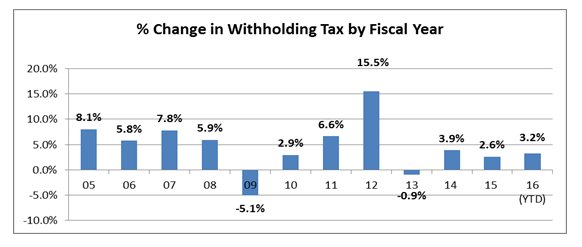
The latest job and wage report from the Department of Labor was positive. The
Department reported that the state added 3,500 jobs in April 2016 to a level of
1,689,800. Statewide nonagricultural employment gains now tally 20,100 (1.20
percent, 1,675 per month) since April 2015. The initial announcement of a
300-job gain for March 2016 was revised upward to 1,000.
Connecticut has now recovered 95,600 positions, or 80.3 percent of the 119,100
seasonally adjusted total nonfarm jobs that were lost in the state during the
March
2008 - February 2010 employment recession. The state needs to reach the
1,713,300 seasonally-adjusted job mark to enter a true nonfarm employment
expansion. This will require 23,500 more nonfarm jobs. Connecticut’s nonfarm
jobs recovery is now 74 months old and is averaging about 1,292 jobs per month
since February 2010.
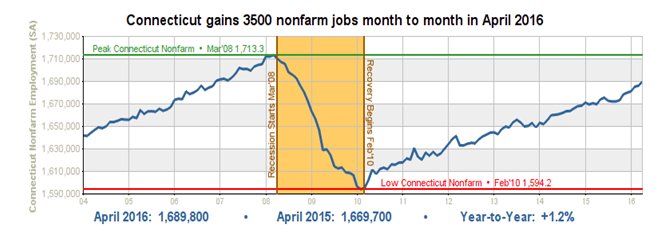
As the state’s employment recovery has progressed, an increasing number of job
sectors have posted sustained employment gains. As this trend continues,
improved wage growth and withholding receipts should occur.
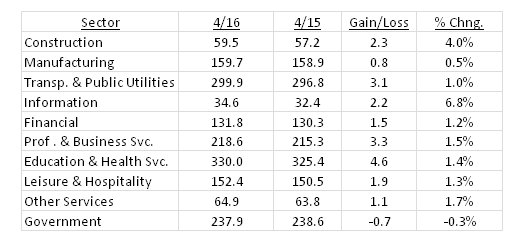
U.S. employment has been advancing at a rate of 1.9 percent over the 12-month
period ending in April; Connecticut’s employment growth was 1.2 percent for the
same period.
Connecticut’s unemployment rate was 5.7 percent in April; the national
unemployment rate was 5 percent. Connecticut’s unemployment rate has continued
to decline from a high of 9.5 percent in October 2010.
There were 109,500 unemployed job seekers in Connecticut in March. A low of
36,500 unemployed workers was recorded in October of 2000. The number of
unemployed workers hit a recessionary high of 177,200 in December of 2010.
![]()
The Department of Labor reported that average hourly earnings at $30.48, not
seasonally adjusted, were up $1.75, or 6.1 percent, from the April 2015 hourly
earnings estimate. The resultant average private-sector weekly pay was
calculated at $1,021.08, up $58.62, or 6.1 percent higher than a year ago. The
Department of Labor notes that other data sources do not support this aggressive
level of wage growth in Connecticut.
The Consumer Price Index for All Urban Consumers (CPI-U, U.S. City Average,
not seasonally adjusted) in April 2016 was 1.1 percent.
Connecticut ranked 39th nationally in income growth for the 2015 calendar year
based on personal income statistics released by the Bureau of Economic Analysis
on March 24. Personal income grew by 3.1 percent in the state during 2015.
Connecticut ranked number one in per-capita personal income at $66,972.
The chart below shows the trend in Connecticut personal income, which has yet
to attain its past expansionary strength. Data for the 1st quarter of 2016 will
be released on June 22.
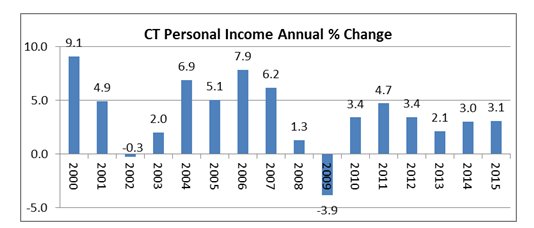
In 2015, Connecticut ranked number two in the nation in the number of
households per capita with investable assets of over $1 million. According to
Phoenix Global Wealth Monitor, 100,996 or 7.3 percent of households in the state
were millionaires. The state also held this ranking in 2014.

According to a May 10 release by the Warren Group, single family home sales in
Connecticut grew by 20.9 percent in March from the same month last year.
Connecticut recorded 2,139 single-family home sales in March 2016, the most
sales in the month of March since 2007. Condominium sales were also strong,
growing 11 percent from last March with 564 new purchases.
Single-family home prices in Connecticut continued to be soft. The sales price
dropped by 3 percent in March to $225,000 compared to $232,000 a year ago.
Condominium prices also fell from $150,000 to $145,000, a 3.3-percent drop from
last March.
In April national foreclosure activity was down 20 percent from last year.
Counter to the national trend, foreclosure activity did increase from a year ago
in 17 states, including Connecticut (up 61 percent), Massachusetts (up 43
percent), Virginia (up 16 percent), Maryland (up 10 percent), and New Jersey (up
5 percent).
Inventory for single-family homes in Connecticut was nine months for the 1st
quarter of 2016, up from 7.9 months in the same quarter last year. Inventory for
condominiums was 8.5 months, up slightly from 8.1 months in First Quarter 2015.
This number tells you how many months it would take for all the current homes on
the market to sell, given the monthly sales volume. Four to five months of
supply is average. As the number rises it indicates that there are more sellers
than buyers, or a buyer’s market.
The table below shows sales activity in March 2016 by county as compared to
last February.
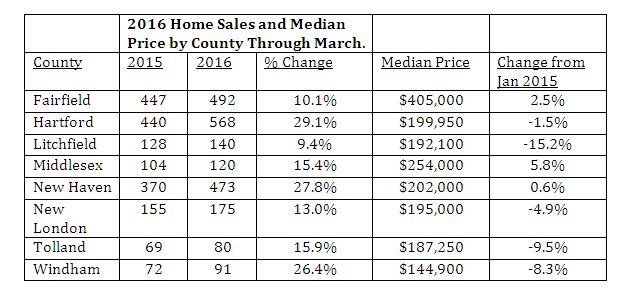
Consumers
Consumer spending data released this month has pointed to strong household
spending. The Commerce Department reported strong retail sales numbers for April
following a March decline. The April growth in consumer spending of 1.3 percent
was the largest gain since March of 2015.
Core sales, the figures that are used to calculate gross domestic product and
which exclude such categories as autos, gasoline stations and building
materials, advanced a solid 0.9 percent last month, the most since March 2014.
Car sales and on-line buying were responsible for much of April’s spending
gains.
Retail sales aren't the only determinant of overall consumer spending in the
U.S. The Commerce Department’s separate selective services report documents
consumer spending on utilities, transportation, education, administrative
support and professional services, among other expenditures that aren't captured
in the retail sales report. This is a quarterly rather than a monthly report.
The 4th quarter of 2015 posted solid consumer spending numbers. Growth of 1.5
percent was reported in that quarter. Results for the 1st quarter of 2016 will
not be available until June 8.
The University of Michigan’s preliminary May index rose to 95.8, the highest
level since June of 2015. More people were expecting to see their incomes rise
and the economy to improve over the next six months. They also anticipated gains
in home values during the year ahead in the highest numbers since records began
in 2007. Economists note that the broad-based nature of the rebound in
confidence underscores a renewed sense of optimism among U.S. households, and it
could augur well for consumer spending going forward.
The Federal Reserve’s May report on consumer borrowing showed 10-percent
growth in consumer credit in March. The use of revolving credit, mostly credit
cards, rose a solid 14.2 percent. Non-revolving credit, which includes student
loans, increased 8.5 percent.
The graph below shows the general upward trend in consumer borrowing since the
end of the recession (the recession period is shaded). The March number is a
post-recession high.
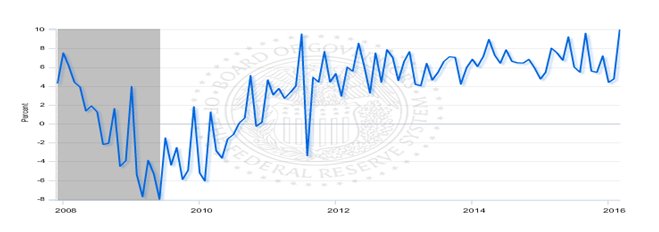
After hitting 11 percent in December of 2012, the personal savings rate has
fluctuated around a 5-percent average since 2013.
Business and Economic Growth

Business and Economic Growth
According to the May 27 second estimate by the Bureau of Economic Analysis,
GDP in the 1st quarter of 2016 grew at a 0.8 percent annual rate. This is an
upward revision from the 0.5 percent advance estimate. In the 4th quarter GDP
expanded by 1.4 percent. The increase in real GDP in the first quarter primarily
reflected positive contributions from personal consumption expenditures,
residential fixed investment, and state and local government spending that were
partly offset by negative contributions from nonresidential fixed investment,
exports, private inventory investment, and federal government spending. Imports,
which are a subtraction in the calculation of GDP, decreased.
Corporate profits were positive in the 1st quarter growing 0.3 percent, but
were down 5.8 percent from the 1st quarter of 2015. The modest rebound came
after two consecutive quarters of falling profits. Weakness in profits is likely
contributing to the recent national pullback in business spending and hiring
growth. The first quarter saw the steepest decline in fixed nonresidential
investment—a proxy for U.S. business spending—since the tail end of the 2007-09
recession, including sharply
lower spending on structures and equipment. Much, but far from all, of the
weakness stems from the energy sector.
The Commerce Department’s May 26 report showed orders for durable goods (items
ranging from toasters to aircraft meant to last three years or more) jumped 3.4%
last month after an upwardly revised 1.9-percent increase in March. The rise in
durable goods orders last month was led by an 8.9-percent jump in bookings for
transportation equipment. Orders for civilian aircraft soared 64.9 percent.
Non-defense capital goods orders excluding aircraft, a closely watched proxy
for business spending plans, fell 0.8 percent after an upwardly revised
0.1-percent drop the prior month. These so-called core capital goods orders have
now declined for three consecutive months.
The service sector of the economy delivered disappointing results in May. The
seasonally adjusted Markit Flash U.S. Services PMI Business Activity Index
registered 51.2 in May continuing to point to modest expansion.
However, the index was down from 52.8 in April and much weaker than the
long-run survey average of 55.6. Service providers report the slowest rate of
staff hiring since December 2014. Business optimism dropped to its lowest level
since October of 2009.
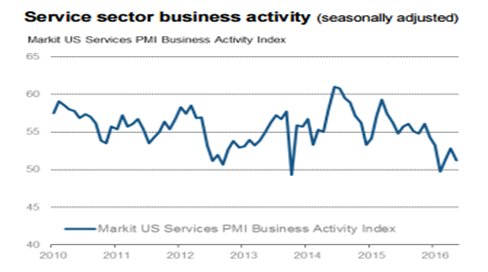
In Connecticut, the business trends tracked by the Department of Labor-- which
include housing permits, exports, gaming slots, visits to major attractions, air
passenger count, CT manufacturing production index, and weekly hours-- has been
on an upward trend since 2015 and has been strengthening.
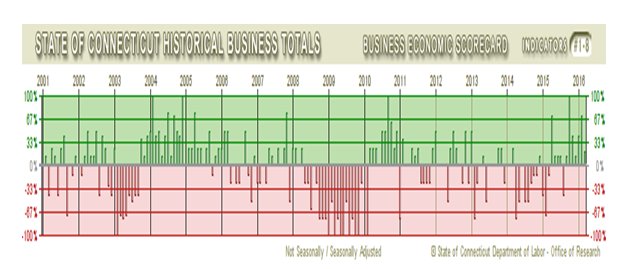
Stock Market
Estimated and final income tax payments account for approximately 40 percent
of total state income tax receipts. These payments show a correlation to
activity in equity markets relating to capital gains.
At the end of April, year-to-date estimated and final income tax payments for
Fiscal Year 2016 were running negative generating $83 million less in revenue
than last fiscal year. Stock market adjustments that impacted Fiscal Year 2016
receipts were the strongest contributing factor in the decline.
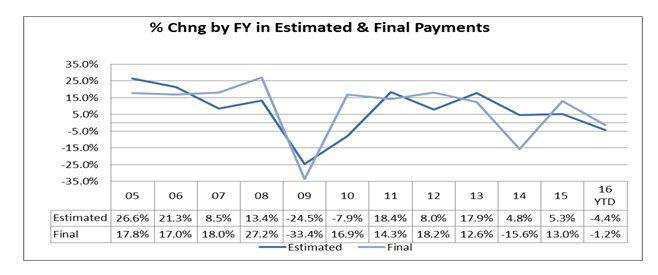
The graphs below show the year-to-date movement in the DOW and the S&P
respectively.
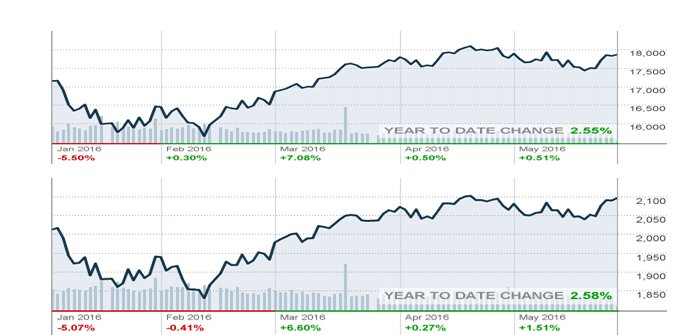
***END***
